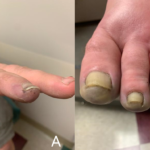Heart valves: One aspect of APS that separates it from other major clotting disorders is valvular disease. (See Table 1, p. 20.) The use of two-dimensional and Doppler echocardiography has shown a variety of lesions, including thrombotic vegetations, thickening, and stenosis. The mitral valve is by far the most commonly involved, with mitral regurgitation reported in up to one-fourth of all patients.
The pathogenesis of valvular lesions is still uncertain. However, in some cases, a rapid combination of thrombosis and valvular degeneration leads to an early requirement for valve surgery.
Kidneys
The discovery of APS has had at least three important consequences in nephrology. First, it has altered the focus of renal biopsy in lupus to include renal microthrombosis. Second, it has proved an important prognostic (and therapeutic) indicator in renal transplantation. Third, it has revealed the interesting discovery of renal artery stenosis and hypertension associated with aPL.
Marie-Carmen Amigo, MD, and her colleagues at the Instituto Nacional de Cardiologia Ignacio Chavez in Mexico, did much to highlight the important contribution of renal microthrombosis to the pathological picture in lupus, with changes ranging from small occlusive arteriolar thrombotic lesions to severe renal artery hyperplasia and occlusion with renal parenchymal ischemia.8
In renal transplantation, it is clear that patients with APS are at increased risk for post-transplant renal thrombosis and, importantly, that anticoagulant therapy could improve outcome.9 The important experience gained from observations of aPL on the outcome of renal transplantation has led to more routine aPL testing in the fields of liver, heart-lung, and marrow transplant surgery.
The link between renal artery stenosis and APS has been one of the most interesting and potentially one of the most important. In the 1983 description of APS, I reported “these patients’ blood pressure often fluctuates, apparently correlating with the severity of the livedo, suggesting a possible reno-vascular etiology. However, this group of patients rarely has primary renal disease.”2 Recently, my colleagues (notably Shirish Sangle, MD, and David D’Cruz, MD) have published a series of patients with renal artery stenosis and hypertension. In a cohort of 600 patients with aPL, 173 (29%) had definite hypertension requiring therapy.11 We have now built up a series of APS patients with renal artery stenosis, depicted in Figure 1. The lesions are localized and clearly differ from those of atheroma or fibro-muscular dysplasia.
With full anticoagulation, the hypertension in this group of patients proved easier to control. Interestingly, these focal stenotic arterial lesions are seen elsewhere in the body, for example, in the cerebral circulation and in the celiac and mesenteric arteries.

